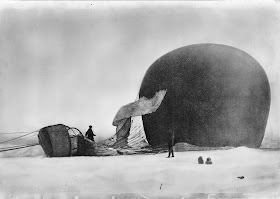 On July 11, 1897, Salomon A. Andrée, Nils Strindberg and Knut Frænkel took off from Dane's Island in the Svalbard archipelago in an attempt to fly over the North Pole in a balloon. Things went badly from the beginning.
On July 11, 1897, Salomon A. Andrée, Nils Strindberg and Knut Frænkel took off from Dane's Island in the Svalbard archipelago in an attempt to fly over the North Pole in a balloon. Things went badly from the beginning.The balloon was overloaded and while it initially started to rise on release, it quickly began to sink as it traveled over the harbor, eventually touching the water. Andrée, Strindberg and Frænkel immediately dumped eight bags of ballast overboard to remedy this. Unfortunately, during the crisis, the drag lines that had been intended to be used as steering lines were lost, which put the balloon's path at the mercy of the wind. Moreover, the loss of ballast, both deliberate and from the loss of the weight of the steering lines, caused the balloon to rise too high, allowing the hydrogen lift gas to escape faster than anticipated. Eventually, the balloon came to rest on the arctic ice. The fate of the crew remained unknown for 33 years.
 In 1930, a Norwegian scientific party discovered the remains of the expedition on White Island. The bodies of the crew were recovered as well as photographs and diaries which recorded their attempts to return to civilization. The flight lasted a little over two days. The attempted return journey on foot across the arctic ice ended three months later with the death of all three members of the expedition. Rauner holds material collected by William Hillman, a reporter, as part of his coverage of the 1930 discovery of the expedition's final camp. The collection includes prints of photographs taken by Frænkel, copies of the articles written by Hillman, and a flyer distributed in Greenland by the Danish government asking the native population to assist Andrée should he be discovered there.
In 1930, a Norwegian scientific party discovered the remains of the expedition on White Island. The bodies of the crew were recovered as well as photographs and diaries which recorded their attempts to return to civilization. The flight lasted a little over two days. The attempted return journey on foot across the arctic ice ended three months later with the death of all three members of the expedition. Rauner holds material collected by William Hillman, a reporter, as part of his coverage of the 1930 discovery of the expedition's final camp. The collection includes prints of photographs taken by Frænkel, copies of the articles written by Hillman, and a flyer distributed in Greenland by the Danish government asking the native population to assist Andrée should he be discovered there.Ask for Stefansson Mss-241 to read the stories accompanied by headlines such as "Heroic Struggle Bared in Notes Found on Bodies" and "Records Reveal Grim Fight For Life Amidst Ice."

No comments:
Post a Comment